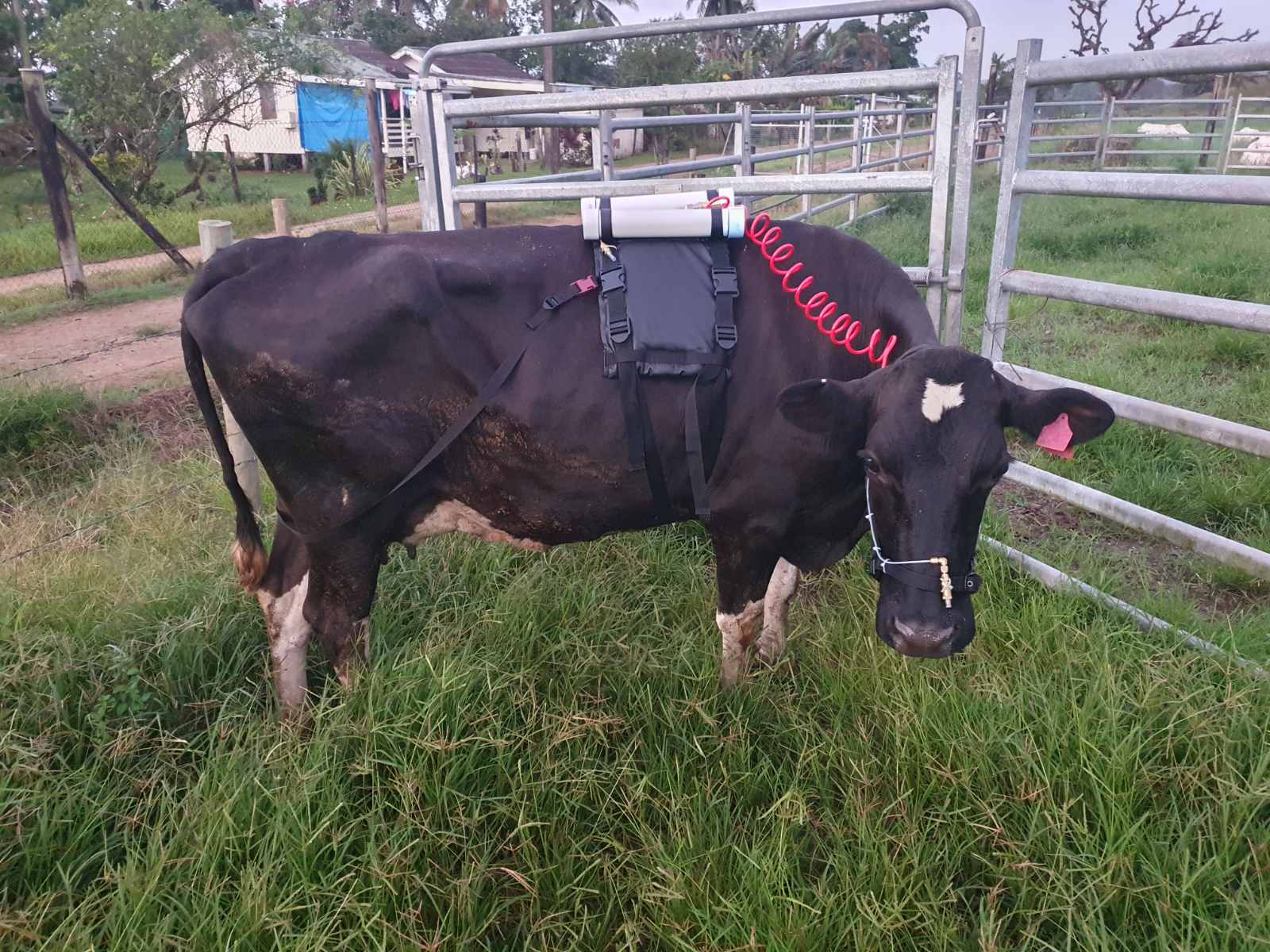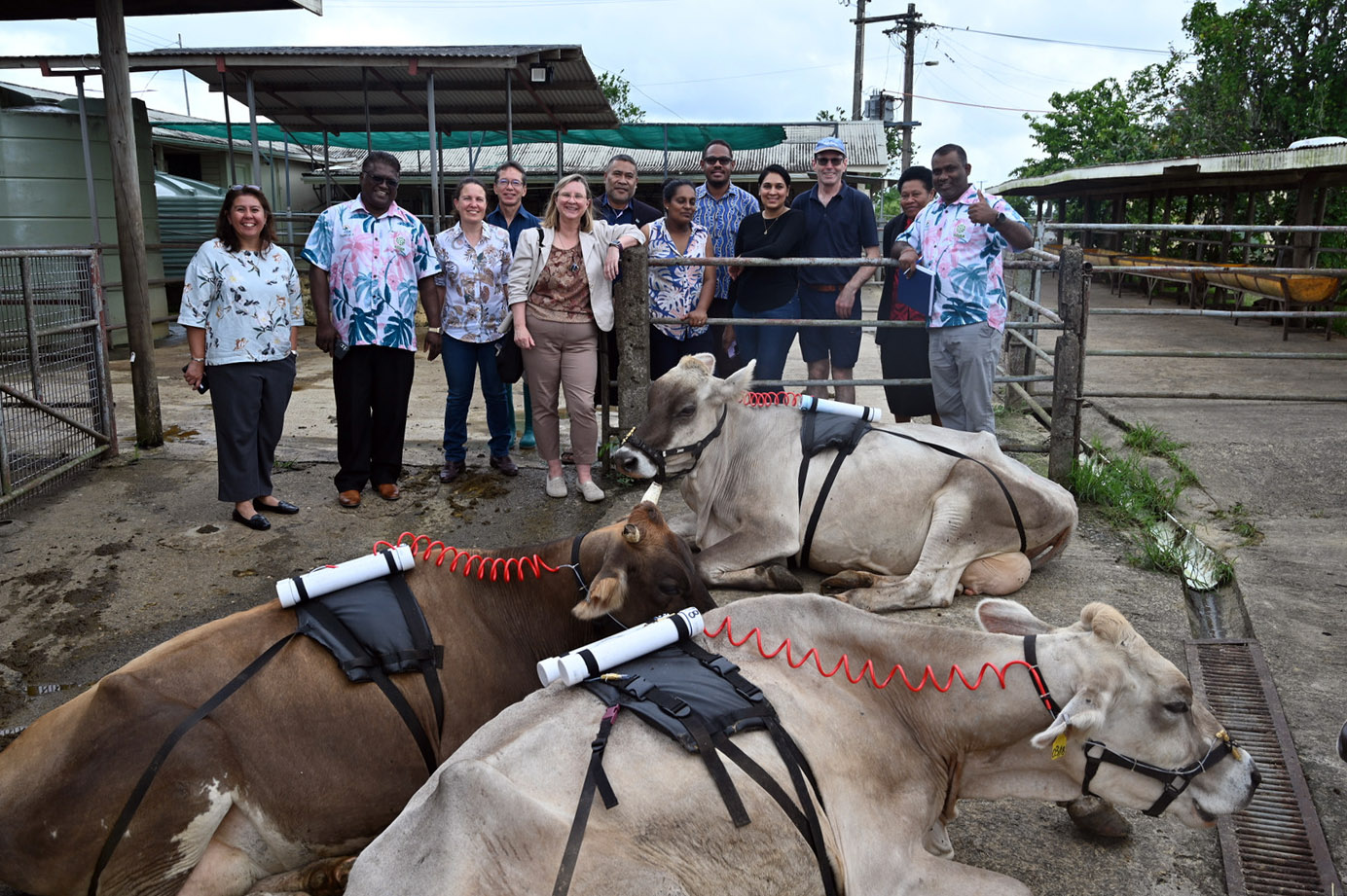In a first for the Pacific, Fiji has measured methane emissions from livestock, marking a significant milestone for the region in managing agricultural greenhouse gas emissions.
The achievement took place as part of ACIAR-funded efforts to enhance Fiji's greenhouse gas inventories and incorporate livestock emissions reduction into its Nationally Determined Contributions (NDC).
Led by Riverine Plains Inc, in close collaboration with the Fiji Government, the initiative is aiming to co-develop a Tier 2 Measurement, Reporting and Verification (MRV) system for livestock, and contribute to Fiji's Low Emission Development Strategy.
Dr Andrew Tukana, Permanent Secretary for Agriculture and Waterways in Fiji, said the development was an important step toward the nation's goal of achieving net zero emissions.
'Developing an accurate, defensible National Inventory is a priority for Fiji as a participating member of the Initiative for Climate Action Transparency (ICAT). The Fiji's NDC also highlights the need to secure climate finance, which is expected to be enabled by a stronger inventory system,' said Dr Tukana.
'We are committed to supporting regional progress on NDC, including inventory development, by hosting the Regional Pacific NDC Hub.'
ACIAR General Manager, Research, Dr James Quilty welcomed the breakthrough, highlighting that the project presents an opportunity to work with in-country partners to develop inventory systems that strengthens good MRV practices.
'Working with Fijian partners will help to build the capacity to develop governance systems, processes and technical expertise required to engage in evidence-based policy and decision making,' said Dr Quilty.
'This investment will empower countries to increase efforts to mitigate GHG emissions, particularly in ways that integrate policy objectives to achieve adaptation and other development co-benefits.'
Dr Natalie Doran-Browne, Project Leader from Riverine Plains, and her team successfully devised a locally adapted method for gauging these emissions, with the project employing the sulphur hexafluoride (SF6) tracer technique to measure cattle emissions.
This involved placing a permeation tube in the cow's rumen to release SF6 gas, which is then measured against methane from around the cow's nostrils and collected as a sample within a canister.
'The technique allows us to determine emission rates from 'breath' samples collected from cows,' explained Dr Doran-Browne. The project is gathering daily data, a positive step toward adjusting Fiji's emission factors to reflect local conditions more accurately.

Dr Doran-Browne collaborates closely with the research staff of the Fiji Koronivia Research Station - Ministry of Agriculture and Waterways, the Ministry of Environment and Climate Change, the University of the South Pacific (USP), and the Fiji National University (FNU) - in collecting, analysing, and interpreting data that will be of value to Fiji. Australian researchers from Agriculture Victoria and Queensland University of Technology also contribute their expertise in measuring methane emissions, data governance and the optimal integration of science and policy.
'Focusing on enteric methane is an important first step towards GHG emission reductions from Fijian agriculture. With the agriculture sector contributing 22% of Fiji's total GHG emissions, enteric methane is responsible for 12% of Fiji's national emissions. To put this in perspective, the Australian agriculture sector and enteric methane contribute 15% and 11% of Australia's national GHG, respectively,' added Dr Doran-Browne
The project also involves Mrs Shalini Verma, a PhD student at USP and ACIAR PASS Scholar, who is currently testing cattle feed and diet at Jay Singh's Dairy Farm in Nausori, about 30 minutes' drive from the capital, Suva.
'Outdoor tests in New Zealand reveal that a cow grazing can emit more than 350 litres of methane per day and that cows fed grain rather than pasture grass emitted about 100 litres per day,' said Mrs Verma.
'So, we can see that total methane emissions from cattle can be significantly reduced through diet. This could be accomplished either by feeding cattle grain or planting more digestible pasture grasses. This in essence is my field of study which I would like to see tested at the commercial dairy farm.'

Research also identified a three-hour cycle in methane production, which peaked after animal feeding at dawn and dusk. Understanding such patterns can inform strategies to reduce emissions effectively. The cycle continues throughout the night as cattle awaken during the night for food. Cows and other animals, such as sheep and goats, chew their cud to ensure the rumen can digest their food. These animals, known as ruminants, release high levels of methane through cud-chewing, almost solely through belching.
According to the indoor estimates of the Intergovernmental Panel on Climate Change, ruminant account for about a sixth of the world's total emissions of methane. Cattle account for about three-quarters of those emissions.
As Dr Doran-Browne, Mrs Verma and the Fiji Government embark on this data collation - Fiji's capacity to improve its national inventory is strengthened more than ever. It lays a formal foundation for a policy that could achieve co-benefits and be replicated to other Pacific island countries.
Learn more via the ACIAR website.






